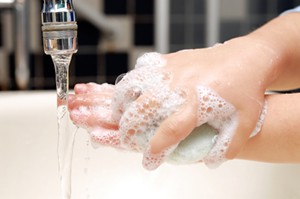
2. Work Practice Controls:
Work practice controls must be evaluated and updated regularly to ensure their effectiveness.
Hand washing:
Hand washing is the most important method in preventing transmission of foodborne or bloodborne pathogens. It is required that you wash your hands after removal of gloves and other PPE.
Cleaning Work surfaces:
The work areas that involve exposure or potential exposure to blood or OPIMs, along with potential contamination of surfaces, must be cleaned regularly. The cleaning must occur at least weekly or after completion of tasks or procedures or at the end of a shift if there is a possibility of contamination. You should use disposable towels to clean up the spill and then dispose of the towels in a biohazard-labeled bag. Use a dustpan and brush, cardboard, or tongs, to clean up any contaminated broken glass. Do not clean it up with your hands.
|
||||
| Course Progression Bar | ||||